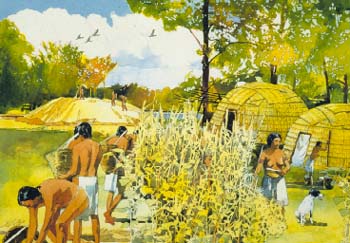
Illinois Agriculture Begins
The earliest food crop remains found in Illinois are that of the squash family. They are considered specialty crops (grown for a specific purpose) rather than staple crops (grown for survival). Traces of squash plants (see image links below) have been found in archaeological sites up to 7,000 years old. These thin-rind, gourd-like squash may have grown with minimal human encouragement. They may not have been cultivated in a formal garden. There may have been additional specialty crops that totally decayed or that have no physical signs of domestication.
There are several theories on the beginning of agriculture by Native Americans. One researcher (Dr. David Asch) has proposed that agriculture began with crops that were desirable but not vital. They were perhaps locally scarce or perishable, had multiple uses, or contained special substances (dyes, poisons, flavorings). These plants, if deliberately grown, supplemented the meat brought in by hunting and the plants collected by gathering. Groups moved around seasonally to regular settlements where they spent up to several months, long enough to sow and grow a crop. They might have chosen to grow plants that were scarce in that location.
Scarcity could be a result of the location of the plants (inconveniently far from settlements), over-collection of the plants by the local group, or difficulty with the large amount of time and labor spent to find the plant in an area.

By growing small amounts of the plant, the people could harvest them more easily and the supply might be steadier. Early farmers burned unwanted plants off the soil, dug holes to plant seeds or seedlings, and fertilized the soil.
Some of these farmers also turned hickory tree stands in the uplands into “orchards” by the annual burning of brush and prairie, and by chopping down some of the trees to allow the canopies of the remaining trees to spread. This encouraged large harvests of nuts.
Early Archaeological Evidence
By 5,000 years ago (in the Late Archaic Era), settlements left behind evidence of the cultivation of the native sumpweed plant (Iva annua). In much of the eastern woodlands, sumpweed grew with goosefoot (Chenopodium berlandieri), common sunflower (Helianthus annuus), and squash (Cucurbita pepo).
The level of agriculture in Illinois remained stable for the next 2,000 years. Then, around 2,000 years ago, more intensive agriculture appeared.
Staple Crops
| Grains | Plants with oily seeds | Plants with fleshy fruit |
| goosefoot (Chenopodium berlandieri) | sumpweed (Iva annua) | pumpkin, squash (Cucurbita pepo) |
| knotweed (Polygonum erectum) | sunflower (Helianthus annuus) | |
| little barley (Hordeum pusillum) | ||
| maygrass (Phalaris caroliniana) |

Tobacco (Nicotiana rustica) and maize (Zea mays) appeared but were not strong staple crops until about 950 years ago.
Beans came into domestication around 700 years ago (the Protohistoric Era). The maize-bean-squash complex eventually replaced the earlier set shown above. All of these staple plants are annuals. Watermelon (Citrullus lanatus), originally from the eastern hemisphere, was cultivated.
It is not known if the squash family was native to Illinois, or if it migrated here naturally as a weed, or if it traveled here with Native American trade or with cultivation of other plants. Some squash and gourds are not edible and were grown to make net floats, ladles, bottles, and other containers.
The Koster Site (https://webdev.museum.state.il.us/muslink/nat_amer/pre/htmls/a_sites.html) (6,000 years ago)
The Napoleon Hollow Site
archaeological remains include carbonized rinds and seeds of gourds.
Cahokia Mounds (Mississippian culture, 1150-1250 AD)
As the population of the village of Cahokia grew during Early Mississippian
(750-800 AD) times, several changes in agricultural practice occurred. There
was expansion of farmed fields to new areas. There was also an increase in
the crop yield per acre achieved by shorter fallow periods, more laborers,
more organization of work, and new technology.
In addition, there was diversification and specialization of crops. Increased yield to support the growing population may have led to the planting of more than one crop on the same land during the year — by following the spring crops of maygrass (Phalaris caroliniana), little barley (Hordeum pusillum) with late-maturing maize and erect knotweed (Polygonum erectum).
The expansion of farming meant some clearing of trees from the land. Archaeological remains of acorns and other nuts show a decrease in local consumption after this expansion of cultivation.
There were two types of maize grown at Cahokia. The Midwestern 12-row type featured 10-14 rows of pyramid-shaped grains per cob. The second type, called North American Pop, had smaller cobs with 16-20 rows of small grains.
https://webdev.museum.state.il.us/muslink/nat_amer/pre/htmls/m_sites.html
Larson site and Dickson Mounds – 1100 AD







